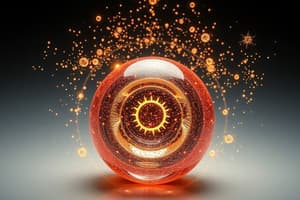Podcast
Questions and Answers
Which of these elements has the smallest atomic radius?
Which of these elements has the smallest atomic radius?
- Nitrogen (N) (correct)
- Fluorine (F)
- Oxygen (O)
- Carbon (C)
Which of these elements has the largest atomic radius: argon, phosphorus, aluminum, sodium, or magnesium?
Which of these elements has the largest atomic radius: argon, phosphorus, aluminum, sodium, or magnesium?
- Sodium (correct)
- Aluminum
- Argon
- Magnesium
- Phosphorus
Which of these elements has the largest atomic radius?
Which of these elements has the largest atomic radius?
- Calcium (Ca)
- Radium (Ra)
- Barium (Ba) (correct)
- Strontium (Sr)
As you move from left to right on the periodic table, why does the atomic radius decrease?
As you move from left to right on the periodic table, why does the atomic radius decrease?
As you move from top to bottom on the periodic table, what happens to the atomic radius?
As you move from top to bottom on the periodic table, what happens to the atomic radius?
Flashcards are hidden until you start studying
Study Notes
Atomic Radius Concepts
- Smallest atomic radius element among choices: Nitrogen (N)
- Largest atomic radius element in the group: Sodium (Na), compared to argon, phosphorus, aluminum, and magnesium
- Largest atomic radius overall in provided options: Barium (Ba)
Trends in Atomic Radius
- Atomic radius decreases as you move from left to right across the periodic table due to increased nuclear charge; more protons attract electrons, pulling them closer to the nucleus.
- Atomic radius increases when moving from top to bottom in a group, as additional electron shells are added, leading to a larger size.
Studying That Suits You
Use AI to generate personalized quizzes and flashcards to suit your learning preferences.




